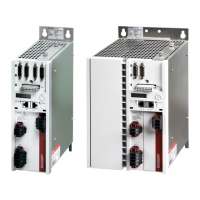Power Management
Function description 73
Version: 1.5
Note
Further information on external brake resistors can be found at:
Information on mechanical and electrical installation, dimensions and technical data can be
found in the system manual for the AX5000 servo drive under: „Accessories – External
brake resistor – AX2090-BW5x-xxxx“.
For further analysis peak values are recorded in the parameters P-0-0220 (internal brake resistor) or P-0-0221 (external) with respect
to the duty cycle.
Duty cycle (DC) = switch-on time / cycle time (machine cycle) x 100%
Beckhoff specifies an overload factor for the brake resistors, depending on the duty cycle (see diagram below):
Multiplied by the power rating, the permissible short-term power results from the overload factor dependent
on the duty cycle:
Short-term power = Power rating x Overload factor (ÜF)
For the AX5000 energy values were calculated for the supported brake resistors from the power rating, duty
cycle and overload factor and saved as parameters. They can be found for the internal brake resistor in
P-0-0207 and after selecting an external brake resistor P-0-0208.
Sample: AX2090BW50-1600 with 47 ohm and 1600W power rating
Overload factor for 1% duty cycle: 30
1% duty cycle for 100s cycle time corresponds to 1s
1s x 1600W x 30 = 48000J
Correspondingly the other saved values result:
Duty cycle [%] 40 20 10 1 0.1
Overload factor 2.2 3.9 7 30 144.375
Peak E. [J] 140800 124800 112000 48000 23100
When the brake resistor becomes active, the software program calculates the current energy values, related
to the duty cycle and presents the maximum values in P-0-0220 or P-0-0221. Both parameters are reset
when the device is restarted (=0). The values entered in operation are preserved until the next restart or until
they are overwritten by the user. They can be compared with the permissible values in P-0-0207 (internal
brake resistor) or P-0-0208 (external). As a result it may be possible to influence the braking power in critical
regions by modifying the cycle.
The greatest percentage value is entered in P-0-0218 or P-0-0219 (in %) (see above).

